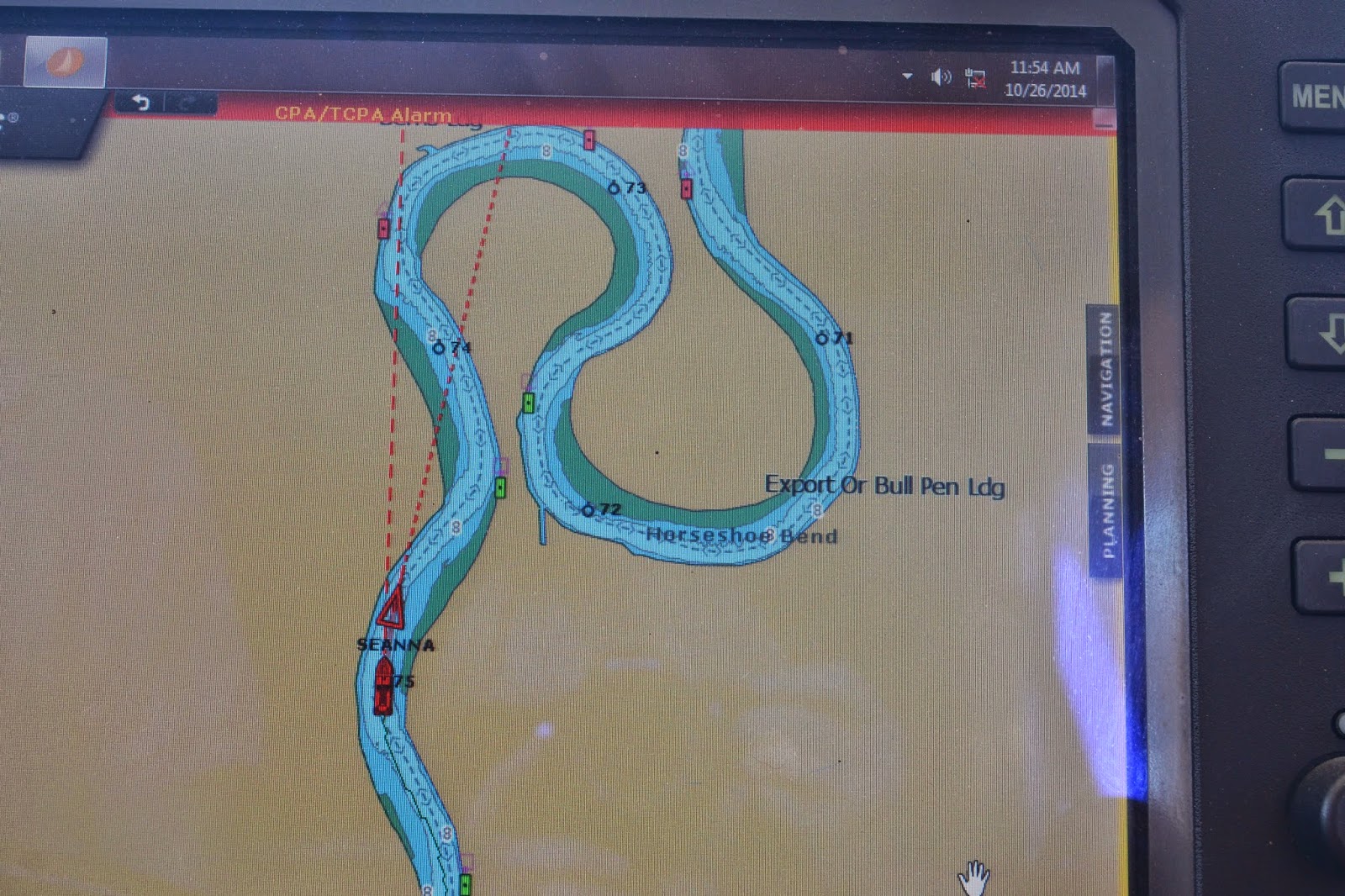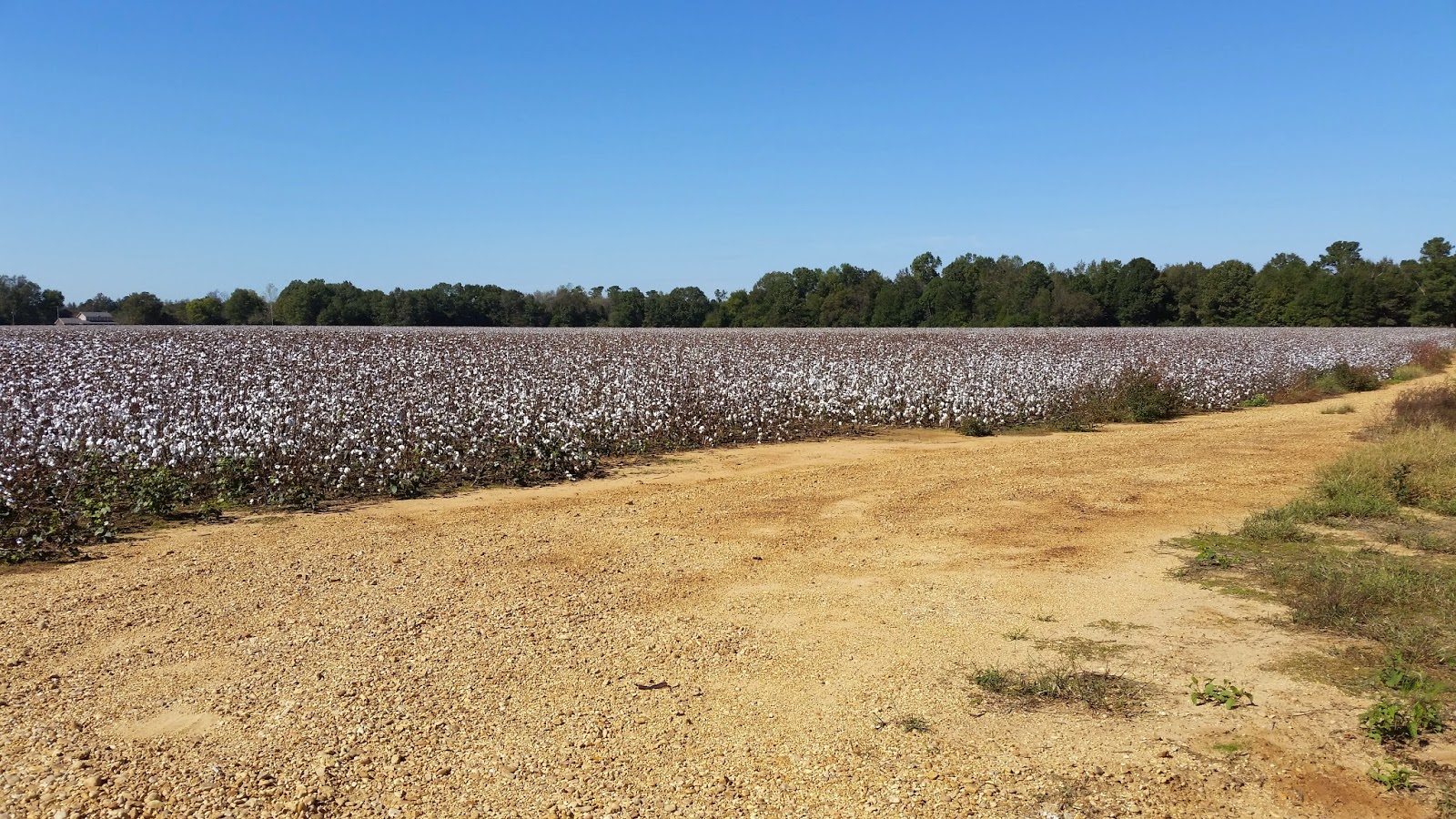After we returned from Memphis we headed south down the Tennessee River. After a week under the shed at Grand Harbor, we looked forward anchoring in Bay Springs Lake for a night or two and exploring the many coves with our dinghy. Unfortunately, for the first time in months we had a full day and a half of rain, plus high wind and tornado warnings. Not good anchoring weather......We ducked into a marina just before the deluge. The following day we locked up three times -- once dropping 84 feet (the deepest lock on the Loop) putting us back into the rhythm of the waterways.
Heading south on the Tennessee then the Tennessee Tombigbee Waterway we had two weeks of spectacular scenery, perfect weather and intermittent nights of docking and anchoring. This was truly the most beautiful part of our trip: patches of trees with yellow, orange and red tipped leaves, eagles flying overhead, misty mornings, fishermen tucked in coves. Fellow experienced Loopers had told us not to expect much barge traffic south of Grand Harbor, but a larger than average grain harvest has put more tows on the waterways and they were once again our nearly constant companions. In fact,if it weren't for the tows we would have been completely alone some days. Once we got into rural northeastern Alabama we went for an entire day without seeing any pleasure crafts other than the ones traveling with us.
Prior to construction of the Tennessee Tombigbee Waterway, the only way for barge traffic to travel from Chicago to the Gulf of Mexico was via the Mississippi, Heavy traffic, current and it's more western location made this a more cumbersome and much longer route, particularly from ports along the eastern Tennessee River
The first known recommendation to connect the Tennessee and Tombigbee Rivers was made by a French explorer, the Marquis de Montcalm, to Louis XV of France in about 1760 or 1770. In 1810 the citizens of what is now Knoxville TN petitioned the Congress to build such a waterway shortening by 800 miles teir distance to the trading ports of New Orleans and Mobile. After numerous surveys, investigations, and proposals, not to mention Congressional stinginess and bickering, the project was finally approved in 1946. 25 years later: As part of his “Southern Strategy” for reelection, President Nixon included $1 million in the Corps of Engineers’ 1971 budget to start construction of the Tenn-Tom. On May 25, 1971, the President traveled to Mobile, Alabama, to participate with then Governor George Wallace and other elected officials from five states to symbolically start construction of the long awaited Tennessee -Tombigbee. However, the actual start of construction was delayed until December 1972 because of a lawsuit filed against the waterway by a small group of environmentalists. The federal courts eventually ruled in favor of the project. (The History of the Tenn-Tom)
Further lawsuits and political wrangling ensued until 1977 when President Jimmy Carter withdrew his opposition and construction of the waterway began, Whew!
After 12 years of construction at a total cost of nearly $2 billion, the Tennessee-Tombigbee Waterway was completed on December 12, 1984. The last plug of earth was removed from the waterway channel at Amory, Mississippi, allowing the long awaited mixing of the waters of the Tombigbee with that of the Tennessee River.
The Tenn-Tom officially opened to commerce on January 10, 1985 when the Towboat,Eddie Waxler, transporting nearly 2.7 million gallons of petroleum products, made its maiden voyage on the waterway. A lottery was held to select the first commercial tow to transit the waterway.
The dedication of the completion of the waterway was held on June 1, 1985. Record hot temperatures did not deter some 100,000 people, including many Members of Congress, Governors, and other elected officials, from attending ceremonies in Columbus, Mississippi and Mobile, Alabama that day. During the previous week, numerous other celebrations were held throughout the four-state waterway corridor from as far away as Paducah, Ky and Gunterville, AL. One newspaper reporter observed that such public exuberance that had been displayed at the Tenn-Tom events had not occurred in this region since those celebrations held at the end of World War II.
It is quite a waterway. Outside of random barge loading facilities, the saw nothing but trees and birds for miles on end. The locks were in great shape and well run -- we seldom had to wait for an opening.
 |
| I enjoyed these intrepid plants nestled in the lock bollards (posts we wrapped a line around as we locked up or down) |
 |
| These plants didn't even need a bollard -- they just grew on the lock wall |
 |
| As we dropped they were a lot further away! |
Where the Tombigbee River was too curvy to allow barge movement, the Corps of Engineers cut straightaways. Some of the "oxbows" left behind are silted in but many can be used as restful anchorages close to the waterway but out of the way of tugs and tows.
Once we hit the Black Warrior-Tombigbee Waterway, the last portion of our route to the Gulf of Mexico, things got a little twistier.
 |
| Here's a shot of our navigation screen from the Black Warrior-Tombigbee Wateerway. That's FREEDOM below where it says Seanna. We were loopin' the river on the Loop! |
Fortunately, our AIS would alert us to an approaching barge and we could slow down and wait for them to come around a curve. I can't imagine not having that technology and rounding a blind curve to find a tug pushing 6-8 barges in my direction, with no where for us to go but into the shallows.
 |
| Meeting a barge in a straight away |
For this portion of the trip we played follow the leader with fellow-Seleners Bart and Beth aboard Seanna. We first met them way back in July in Put-in-Bay, Ohio. Next time we saw them was in Columbus, MS when they tied up next to us while the Selene Passage, was across the dock. It was our own little Selene Owners Rendezvous.
We have continued our system of traveling for several days and then stopping for about a week. Most marinas offer a special weekly rate and staying put for a bit allows us to socialize with fellow Loopers and locals, explore areas of the country we would never get to know otherwise, and head off on a few road trips. In Columbus, MS, for example, we attended the Roast n Boast, the Mississippi State BBQ Championship:
 |
| I am guessing the pigs run extra fast when they hear they are at a BBQ Championship! |
...visited the annual Caledonia Days festival about 30 minutes away; stocked up on greens at the Saturday Farmer's Market; toured the antebellum Waverly Plantation Mansion,in West Point, MS:
 |
| A 400 year old Magnolia tree in the front yard of the mansion. Extensive gardens surround the home. In the 1800's it was a large cotton plantation |
..... and the childhood home of Tennessee Williams:
 |
| The home was orignally sited three blocks away at the parsonage for the local church where his Grandfather was the Rector. When the church expanded, the home was moved to its current location |
drove past cotton fields:
 |
| From a distance it looked like a fresh snow had fallen. The plants were 3-4' high. What backbreaking work it must have been to hand pick. |
and enjoyed docktails and dinner with other Loopers.
It seems that every time you have had enough of something on the Loop: locks or lakes or rivers or tug boats or catfish etc, the scenery changes and a new set of adventures are at hand. We have said goodbye! to the rivers, locks, fresh water, and catfish and hello! Gulf Coast, palm trees, white sand, dolphins on the starboard side and oysters on the menu. It's not a bad thing.....




No comments:
Post a Comment